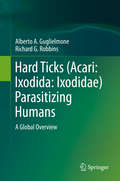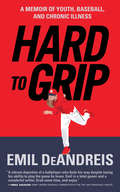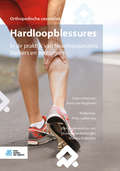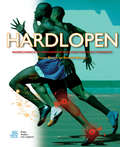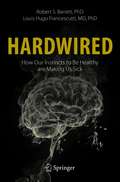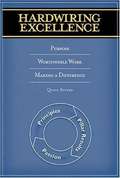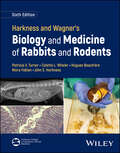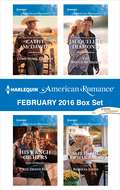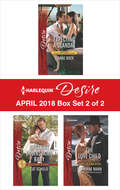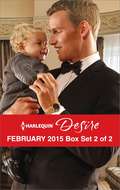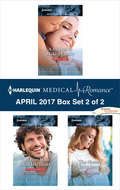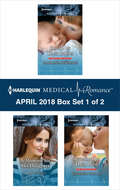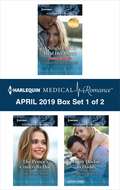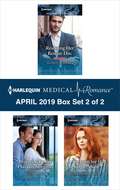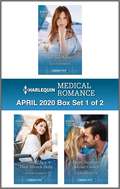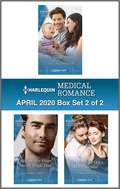- Table View
- List View
Hard Ticks (Acari: A Global Overview
by Alberto A. Guglielmone Richard G. RobbinsTicks of the family Ixodidae, commonly known as hard ticks, occur worldwide and are second only to mosquitoes as vectors of agents pathogenic to humans. Of the 729 currently recognized hard tick species, 283 (39%) have been implicated as human parasites, but the literature on these species is both immense and scattered, with the result that health professionals are often unable to determine whether a particular tick specimen, once identified, represents a species that is an actual or potential threat to its human host. In this book, two leading tick specialists provide a list of the species of Ixodidae that have been reported to feed on humans, with emphasis on their geographical distribution, principal hosts, and the tick life history stages associated with human parasitism. Also included is a discussion of 21 ixodid species that, while having been found on humans, are either not known to have actually fed or may have been misidentified. Additionally, 107 tick names that have appeared in papers on tick parasitism of humans, and that might easily confuse non-taxonomists, are shown to be invalid under the rules of zoological nomenclature. Although the species of ticks that attack humans have long attracted the attention of researchers, few comprehensive studies of these species have been attempted. By gleaning and analyzing the results of over 1,100 scientific papers published worldwide, the authors have provided an invaluable survey of hard tick parasitism that is unprecedented in its scope and detail.
Hard to Grip
by Emil DeAndreisHard to Grip, a memoir by native San Franciscan Emil DeAndreis is a love story to baseball that is also a frank, and humorous account of the author’s struggles with rheumatoid arthritis, the chronic illness that threw a curve into his life and dashed the hopes of becoming a professional pitcher in the major leagues that he had harbored since he was old enough to throw a ball. Scarcely out of Lowell high school where he was an up-and-coming star pitcher for his two-time championship team, Emil discovered the early signs of the disease were hampering his ability to compete, and it became increasingly evident to him as he played throughout his freshman and sophomore years in the D1 Leagues for University of Hawaii/Hilo that his lifelong dream to go pro was to be only that—a dream. Even as he was being courted by the big leagues and about to sign on to play pro ball in Europe. Hard to Grip is a personable, humor-filled and inspirational story of a robust, athletic young man who, barely into his twenties, must confront the reality of living with a physical illness, and the crushing disappointment of not being able to fulfill his lifelong wish, but, who at the same time learns to embrace that one thing he loves in order to forge a new life with a different perspective: as a high school coach for his alma mater, Lowell. Moreover, it is also a story of love for a girl, for his friends, for his family, hometown of San Francisco and the game itself.
Hardloopblessures: In de praktijk van fysiotherapeuten, trainers en verzorgers (Orthopedische casuïstiek)
by Koos Van Nugteren Patty JoldersmaHardlopen is een van de meest populaire sporten ter wereld. Het is tevens een effectieve manier om de gezondheid te verbeteren of te onderhouden. Het vermindert de kans op hart- en vaatziektes, obesitas, diabetes type II en osteoporose. De keerzijde is echter dat hardlopers vaak blessures krijgen.Dit boek beschrijft veelvoorkomende hardloopblessures. Besproken worden onder andere diverse stressfracturen, compartimentsyndroom, mediaal tibiaal stresssyndroom, verschillende oorzaken van hielpijn, tarsaletunnelsyndroom, enkeldistorsie, iliotibiale bandsyndroom, het patellofemoraal pijnsyndroom, patellapeestendinose, achillespeestendinose, meniscuslaesie, hamstringblessure, compartimentsyndroom en verschillende circulatiestoornissen.Zoals gebruikelijk in de boekenreeks van Orthopedische Casuïstiek wordt ieder onderwerp besproken aan de hand van patiëntencasuïstiek uit de dagelijkse praktijk.De tekst is rijk geïllustreerd met educatieve tekeningen en foto’s. De bijlagen achterin het boek tonen overzichten van de ‘Ottawa Ankle Rules’ en een overzicht van moeilijk te differentiëren aandoeningen van het onderbeen inclusief symptomatologie.Het boek is in het bijzonder bestemd voor (sport)fysiotherapeuten, kinesitherapeuten, verzorgers van een atletiekvereniging, sportartsen, huisartsen en orthopeden.
Hardlopen: Biomechanica en inspanningsfysiologie praktisch toegepast
by Frans Bosch Ronald KlompDit boek biedt de nieuwste inzichten op het gebied van looptraining.Aan de orde komen innovatieve trainingsconcepten die gebaseerd zijn op recent wetenschappelijk onderzoek en op uitgebreide kennis van de trainingspraktijk.Looptrainers, fysiotherapeuten, leraren lichamelijke opvoeding en hardlopers kunnen hun voordeel doen met deze publicatie.Vanuit biomechanisch en inspanningsfysiologisch perspectief worden onderwerpen als looptechniek, energieleverantie, adaptatie en krachttraining behandeld. Recente wetenschappelijke inzichten worden vertaald naar de trainingspraktijk.In deze derde, ongewijzigde druk zijn allerlei aspecten van looptraining tot in detail uitgewerkt. Talrijke illustraties en foto's verhelderen de uiteenzettingen over lopen op hoge snelheid, loopscholing en krachttraining.
Hardware/Software Co-Design and Optimization for Cyberphysical Integration in Digital Microfluidic Biochips
by Krishnendu Chakrabarty Yan Luo Tsung-Yi HoThis book describes a comprehensive framework for hardware/software co-design, optimization, and use of robust, low-cost, and cyberphysical digital microfluidic systems. Readers with a background in electronic design automation will find this book to be a valuable reference for leveraging conventional VLSI CAD techniques for emerging technologies, e. g. , biochips or bioMEMS. Readers from the circuit/system design community will benefit from methods presented to extend design and testing techniques from microelectronics to mixed-technology microsystems. For readers from the microfluidics domain, this book presents a new design and development strategy for cyberphysical microfluidics-based biochips suitable for large-scale bioassay applications. * Takes a transformative, "cyberphysical" approach towards achieving closed-loop and sensor feedback-driven biochip operation under program control; * Presents a "physically-aware" system reconfiguration technique that uses sensor data at intermediate checkpoints to dynamically reconfigure biochips; * Enables readers to simplify the structure of biochips, while facilitating the "general-purpose" use of digital microfluidic biochips for a wider range of applications.
Hardwired: How Our Instincts to Be Healthy are Making Us Sick
by Robert S. Barrett Louis Hugo FrancescuttiFor the first time in a thousand years, Americans are experiencing a reversal in lifespan. Despite living in one of the safest and most secure eras in human history, one in five adults suffers from anxiety as does one-third of adolescents. Nearly half of the US population is overweight or obese and one-third of Americans suffer from chronic pain – the highest level in the world. In the United States, fatalities due to prescription pain medications now surpass those of heroin and cocaine combined, and each year 10% of all students on American college campuses contemplate suicide. With the proliferation of social media and the algorithms for social sharing that prey upon our emotional brains, inaccurate or misleading health articles and videos now move faster through social media networks than do reputable ones. This book is about modern health – or lack of it. The authors make two key arguments: that our deteriorating wellness is rapidly becoming a health emergency, and two, that much of these trends are rooted in the way our highly evolved hardwired brains and bodies deal with modern social change. The co-authors: a PhD from the world of social science and an MD from the world of medicine – combine forces to bring this emerging human crisis to light. Densely packed with fascinating facts and little-told stories, the authors weave together real-life cases that describe how our ancient evolutionary drives are propelling us toward ill health and disease. Over the course of seven chapters, the authors unlock the mysteries of our top health vices: why hospitals are more dangerous than warzones, our addiction to sugar, salt, and stress, our emotionally-driven brains, our relentless pursuit of happiness, our sleepless society, our understanding of risk, and finally, how world history can be a valuable tutor. Through these varied themes, the authors illustrate how our social lives are more of a determinant of health outcome than at any other time in our history, and to truly understand our plight, we need to recognize when our decisions and behavior are being directed by our survival-seeking hardwired brains and bodies.
Hardwiring Excellence
by Quint StuderHardwiring Excellence offers a road map and practical how-to guide for creating and sustaining a culture of service and operational excellence. In this book, author Quint Studer, CEO of Studer Group, draws on his personal experience as a former hospital executive who led two organizations to the top 1% in patient satisfaction and his experience coaching hundreds of healthcare organizations since.
Hark, Hark! Hear the Story of a Science Educator (Global Science Education)
by Jazlin EbenezerHark, Hark! Hear the Story of a Science Educator highlights some compelling ideas on science teaching and learning through the author’s journey and includes evolution and revolution in the growth of scientific knowledge. The book discusses views of McComas et al. and Lederman et al. on the nature of science, as well as the learning theories of Piaget (1926), Vygotsky (1978), and Marton (1981). The three theories of learning frame methods in teaching science. The author is well known in the science education research community for her groundbreaking work in student conceptions and conceptual change, particularly as related to phenomenography. Key Features: Helps science educators explore new avenues related to various innovative curricula, teaching, and learning Presents abstract learning theories, such as social constructivism in personal stories and experiences Bridges the divide between the science education community and the general public on significant ideas of science teaching and learning Uncovers relational conceptual change inquiry learning Discusses current socioscientific community-based issues—other-centeredness—through scientific investigation and engineering design challenges
Harkness and Wagner's Biology and Medicine of Rabbits and Rodents
by Colette L. Wheler John E. Harkness Patricia V. Turner Susan VandeWoudeHarkness and Wagner's Biology and Medicine of Rabbits and Rodents, Fifth Edition is a practical reference in small mammal husbandry and health, encompassing the fields of laboratory animal medicine and pet practice. Part of ACLAM's series of laboratory animal books, this text offers concise but complete coverage on rabbits and the most common rodent species, with an emphasis on biology, clinical procedures, clinical signs, and diseases and conditions. By providing useful, accessible assessment and diagnostic information, Harkness and Wagner's Biology and Medicine of Rabbits and Rodents aids the practitioner in diagnosing and treating conditions in small mammals.
Harkness and Wagner's Biology and Medicine of Rabbits and Rodents
by Colette L. Wheler John E. Harkness Patricia V. Turner Hugues Beaufrère Niora FabianPractical reference on small mammal husbandry and health, now with full-color clinical photographs throughout The Sixth Edition of Harkness and Wagner’s Biology and Medicine of Rabbits and Rodents provides a thorough update to the classic reference on small mammal health and husbandry, now with full-color clinical photographs throughout. Part of ACLAM’s series of laboratory animal books, the book is a comprehensive, practical guide to caring for rabbits, guinea pigs, hamsters, gerbils, mice, rats, and chinchillas. Emphasizing biology, contemporary husbandry, diagnostics and clinical procedures, clinical signs, and diseases and conditions, the book is equally useful in the research, companion animal practice, or food animal setting. New topics for the Sixth Edition include environmental monitoring for rodent health assessments, behavioral management considerations for optimizing animal health, enhanced pain assessment approaches, as well as considerations for creating a welfare-friendly small mammal practice. The Sixth Edition also updates common therapeutics, analgesics, anesthetics, and blood collection methodology, disease biology, husbandry, diagnostic modalities, and references, and covers new techniques for creating and modifying genetically engineered rodents. Harkness and Wagner’s Biology and Medicine of Rabbits and Rodents includes information on: General husbandry and disease prevention, covering equipment needs, factors predisposing to disease, and occupational health and safety issuesClinical procedures, covering hematology, clinical chemistry, urinalysis, surgery, post-operative care, dentistry, ophthalmology, and imagingClinical signs and differential diagnoses, covering astroviruses, hepatitis E and leporid herpesvirus-4 for rabbits and antimicrobial resistance for commercial rabbitsSerologic testing and diagnostic sample submission, covering newer methodologies, environmental monitoring, and considerations for large rodent feeder-breeder operations The Sixth Edition of Harkness and Wagner’s Biology and Medicine of Rabbits and Rodents is an essential reference for veterinary professionals dealing with small mammal species in research or practice settings, as well as veterinary students interested in small animals, comparative medicine, or laboratory animal medicine.
Harlequin American Romance February 2016 Box Set: An Anthology
by Jacqueline Diamond Roz Denny Fox Cathy Mcdavid Patricia JohnsHarlequin American Romance brings you four new all-American romances for one great price, available now! This box set includes: COME HOME, COWBOY Mustang Valley * by Cathy McDavid Single dad Josh Dempsey returns to the Dos Estrellas Ranch to start over. Cara Alverez operates a mustang sanctuary on the ranch and isn't ready for a romantic relationship...but Josh is intent on changing her mind. HIS RANCH OR HERS Snowy Owl Ranchers * by Roz Denny Fox Being in the Green Berets prepared Zeke Maxwell for anything--anything except inheriting a ranch and an ornery forewoman who wants the land herself. Can he convince Myra Odell he belongs on the ranch...and in her heart? THE WOULD-BE DADDY Safe Harbor Medical * by Jacqueline Diamond Psychologist Franca Brightman and surgeon Marshall Davis have completely different opinions on almost everything--but especially about children. So when an unexpected night of passion leads to pregnancy, will it mean war...or a wedding? SAFE IN THE LAWMAN'S ARMS Hope, Montana * by Patricia Johns Montana sheriff Mike Cruise has short-term custody of his young niece Katy, so he hires pregnant nanny Mallory Smythe. But when he must protect Katy and Mallory from an outside threat, Mike realizes he wants more than temporary! If you love small towns and cowboys, watch out for 4 new Harlequin American Romance titles every month! Romance the all-American way! Join HarlequinMyRewards.com to earn FREE books and more. Earn points for all your Harlequin purchases from wherever you shop.
Harlequin Desire April 2018 Box Set - 2 of 2: Expecting A Scandal Upstairs Downstairs Baby The Love Child
by Catherine Mann Joanne Rock Cat SchieldDo you love stories with sexy, romantic heroes who have it all—wealth, status, and incredibly good looks? Harlequin® Desire brings you all this and more with these three new full-length titles in one collection! #2582 EXPECTING A SCANDALTexas Cattleman’s Club: The Impostorby Joanne RockWealthy trauma surgeon Vaughn Chambers spends his days saving lives and his nights riding the ranch. But when it comes to healing his own heart, he finds solace only in the arms of Abigail Stewart, who’s pregnant with another man’s baby…#2583 UPSTAIRS DOWNSTAIRS BABYBillionaires and Babiesby Cat SchieldSingle mom Claire Robbins knows her boss is expected to marry well. Taking up with the housekeeper is just not done—especially if her past catches up to her. Falling for Linc would be the ultimate scandal. But she’s never been good at resisting temptation…#2584 THE LOVE CHILDAlaskan Oil Baronsby Catherine MannWhen reclusive billionaire rancher Trystan Mikkelson is thrust into the limelight, he needs a media makeover! Image consultant Isabeau Waters guarantees she can turn him into the face of his family’s empire. But one night of passion leads to pregnancy, and it could cost them everything.Look for Harlequin® Desire’s April 2018 Box Set 1 of 2, filled with even more scandalous stories and powerful heroes!Join HarlequinMyRewards.com to earn FREE books and more. Earn points for all your Harlequin purchases from wherever you shop.
Harlequin Desire February 2015 - Box Set 2 of 2
by Merline Lovelace Charlene Sands Dani WadeDo you love stories with sexy, romantic heroes who have it all--wealth, status, and incredibly good looks? Harlequin® Desire brings you all this and more with these three new full-length titles for one great price! This Desire bundle includes The Blackstone Heir by Dani Wade, Her Forbidden Cowboy by USA TODAY bestselling author Charlene Sands and The Texan's Royal M.D. by USA TODAY bestselling author Merline Lovelace.Look for 6 new compelling stories every month from Harlequin® Desire!
Harlequin Desire February 2016 - Box Set 2 of 2
by Michelle Celmer Kathie Denosky Janice MaynardDo you love stories with sexy, romantic heroes who have it all--wealth, status, and incredibly good looks? Harlequin® Desire brings you all this and more with these three new full-length titles with bonus short story -- Never Too Late by Brenda Jackson for one great price! The Doctor's Baby Dare (Texas Cattleman's Club: Lies and Lullabies) Michelle Celmer Dr. Parker Reese always gets what he wants, especially when it comes to women. When a baby shakes up his world, he decides he wants sexy nurse Clare Connelly... Will he have to risk his guarded heart to get her? How to Sleep with the Boss (The Kavanaghs of Silver Glen) Janice Maynard Ex-heiress Libby Parkhurst has nothing to lose when she takes a demanding job with Patrick Kavanagh, but her desire to impress the boss is complicated when his matchmaking family gives her a makeover that makes Patrick lose control. Tempted by the Texan (The Good, the Bad and the Texan) Kathie DeNosky Wealthy rancher Jaron Lambert wants more than just one night with Mariah Stanton, but his dark past and their age difference hold him back. What will it take to push past his boundaries? Mariah's about to find out... Look for Harlequin® Desire's February 2016 Box set 1 of 2, filled with even more scandalous stories and powerful heroes' Join HarlequinMyRewards.com to earn FREE books and more. Earn points for all your Harlequin purchases from wherever you shop.
Harlequin Desire March 2015 - Box Set 1 of 2
by Michelle Celmer Yvonne Lindsay Olivia GatesDo you love stories with sexy, romantic heroes who have it all--wealth, status, and incredibly good looks? Harlequin® Desire brings you all this and more with these three new full-length titles for one great price! This Desire bundle includes Pregnant by the Sheikh by USA TODAY bestselling author Olivia Gates, More Than a Convenient Bride by USA TODAY bestselling author Michelle Celmer and The Wedding Bargain by USA TODAY bestselling author Yvonne Lindsay.Look for 6 new compelling stories every month from Harlequin Desire!
Harlequin Medical Romance April 2016 - Box Set 1 of 2: Seduced by the Heart Surgeon\The Fling That Changed Everything\The Greek Doctor's Secret Son
by Alison Roberts Carol Marinelli Jennifer TaylorHarlequin® Medical Romance brings you three new titles every month, available now! Enjoy these stories packed with pulse-racing romance and heart-racing medical drama. This Harlequin® Medical Romance box set includes: SEDUCED BY THE HEART SURGEON The Hollywood Hills Clinic by Carol Marinelli Freya Rothsberg has one wild night of passion with surgeon Zack Carlton...before discovering he's her newest colleague! THE FLING THAT CHANGED EVERYTHING Wildfire Island Docs by Alison Roberts Paramedic Lia Roselli tempts new boss Dr. Sam Taylor to risk everything for their shared passion... THE GREEK DOCTOR'S SECRET SON by Jennifer TaylorCould nurse Amy Prentice's shock reunion with Dr. Nico Leonides lead to the family they've dreamed of? Look for six new captivating love stories every month from Harlequin® Medical Romance! Join HarlequinMyRewards.com to earn FREE books and more. Earn points for all your Harlequin purchases from wherever you shop.
Harlequin Medical Romance April 2016 - Box Set 2 of 2: Falling for the Single Dad\A Child to Open Their Hearts\Caught in a Storm of Passion
by Marion Lennox Emily Forbes Lucy RyderHarlequin® Medical Romance brings you three new titles every month, available now! Enjoy these stories packed with pulse-racing romance and heart-racing medical drama. This Harlequin® Medical Romance box set includes: FALLING FOR THE SINGLE DAD The Hollywood Hills Clinic by Emily ForbesHas ex-army doc Abi Thompson found happiness against all odds with her new boss, Dr. Damien Moore? A CHILD TO OPEN THEIR HEARTS Wildfire Island Docs by Marion Lennox Orphan Joni is Hettie De Lacey's last chance to be a mom...but she needs Dr. Max Lockhart's help! CAUGHT IN A STORM OF PASSION by Lucy RyderTrapped on an island with sexy Chase Gallagher, Eve Carmichael indulges in a hot fling in paradise! Look for six new captivating love stories every month from Harlequin® Medical Romance! Join HarlequinMyRewards.com to earn FREE books and more. Earn points for all your Harlequin purchases from wherever you shop.
Harlequin Medical Romance April 2017 - Box Set 1 of 2: Their One Night Baby\Forbidden to the Playboy Surgeon\Reunited by Their Pregnancy Surprise
by Carol Marinelli Fiona Lowe Louisa HeatonHarlequin® Medical Romance brings you a collection of three new titles, available now! Enjoy these stories packed with pulse-racing romance and heart-racing medical drama. This Harlequin Medical Romance box set includes: THEIR ONE NIGHT BABYPaddington Children's Hospitalby Carol MarinelliDr. Dominic MacBride had no intention of falling in love—yet now he's fighting for paramedic Victoria Christie…and their surprise baby! FORBIDDEN TO THE PLAYBOY SURGEONPaddington Children's Hospitalby Fiona LoweNeurosurgeon Alistair North and Claire Mitchell both have secrets, but giving in to desire could turn their forbidden passion into forever… REUNITED BY THEIR PREGNANCY SURPRISE by Louisa HeatonObstetrician Sam Saint wakes in hospital with no memory to discover the women at his bedside is Emily, his pregnant wife! Join HarlequinMyRewards.com to earn FREE books and more. Earn points for all your Harlequin purchases from wherever you shop.
Harlequin Medical Romance April 2017 - Box Set 2 of 2: A Mother to Make a Family\The Boss Who Stole Her Heart\The Nurse's Baby Secret
by Jennifer Taylor Janice Lynn Emily ForbesHarlequin® Medical Romance brings you a collection of three new titles, available now! Enjoy these stories packed with pulse-racing romance and heart-racing medical drama. This Harlequin Medical Romance box set includes: A MOTHER TO MAKE A FAMILYTempted & Tamedby Emily ForbesFor Rose Anderson, falling in love has always felt like a fantasy… Can Dr. Mitch Reynolds make her dream come true? THE BOSS WHO STOLE HER HEARTThe Larches Practiceby Jennifer TaylorEllie Munro planned a new start. It wasn't meant to include developing a crush on GP Daniel Saunders—her new boss! THE NURSE'S BABY SECRET by Janice LynnTo win back nurse Savannah Carter, Dr. Charlie Keele must convince her of his love—for her and their unexpected baby… Join HarlequinMyRewards.com to earn FREE books and more. Earn points for all your Harlequin purchases from wherever you shop.
Harlequin Medical Romance April 2018 - Box Set 1 of 2: Bound By Their Babies A Mommy For His Daughter Reunited By Their Baby
by Caroline Anderson Jennifer Taylor Amy RuttanHarlequin Medical Romance brings you a collection of three new titles, available now! Enjoy these stories packed with pulse-racing romance and heart-racing medical drama.This Harlequin Medical Romance box set includes:BOUND BY THEIR BABIESYoxburgh Park Hospitalby Caroline AndersonWhen best friends, obstetricians Jake and Emily, become single parents, there’s only one solution—move in together and try to resist their secret desire for one another!A MOMMY FOR HIS DAUGHTERby Amy RuttanCould doting single dad GP Derek Taylor and his little girl bring Dr. Evelyn Saunders the happy family she’s been looking for?REUNITED BY THEIR BABYThe Larches Practiceby Jennifer TaylorGP Beth Andrews has a wonderful job and a baby girl she adores. The only thing missing is her husband—until Callum O’Neill returns!Join HarlequinMyRewards.com to earn FREE books and more. Earn points for all your Harlequin purchases from wherever you shop.
Harlequin Medical Romance April 2019 - Box Set 1 of 2
by Caroline Anderson Becky Wicks Louisa HeatonHarlequin Medical Romance brings you a collection of three new titles, available now! Enjoy these stories packed with pulse-racing romance and heart-racing medical drama.This Harlequin Medical Romance box set includes:A SINGLE DAD TO HEAL HER HEARTYoxburgh Park Hospitalby Caroline AndersonCan widowed surgeon Matt convince trauma doc and breast cancer survivor Livvy she belongs in his family, whatever the future holds? THE PRINCE’S CINDERELLA DOCby Louisa HeatonLeft homeless, Dr. Krystiana’s world is turned upside down—until her temporary employer, Crown Prince Matteo, offers her a room at the palace!FROM DOCTOR TO DADDYby Becky WicksReunited aboard a Caribbean cruise for kidney dialysis patients, can Dr. Fraser give Sara—and her sick daughter—the future they deserve?
Harlequin Medical Romance April 2019 - Box Set 2 of 2
by Alison Roberts Lucy Ryder Charlotte HawkesHarlequin Medical Romance brings you a collection of three new titles, available now! Enjoy these stories packed with pulse-racing romance and heart-racing medical drama.This Harlequin Medical Romance box set includes:RESISTING HER RESCUE DOCRescue Docsby Alison RobertsStunning adrenaline junkie Fizz Wilson should be off-limits to guarded paramedic Cooper Sinclair—only their chemistry is undeniable…PREGNANT BY THE PLAYBOY SURGEONby Lucy RyderER doc Danielle’s new neighbor, sexy surgeon Dylan, becomes increasingly impossible to ignore and resist… Leading to one red-hot, life-changing night!A SURGEON FOR THE SINGLE MOMby Charlotte HawkesSingle parent and helicopter rescue doc Effie has no time for romance! Then her dating ruse with hotshot neurosurgeon Tak ignites a sizzling connection…
Harlequin Medical Romance April 2020 - Box Set 1 of 2
by Alison Roberts Allie KincheloeHarlequin Medical Romance brings you a collection of three new titles, available now! Enjoy these stories packed with pulse-racing romance and heart-racing medical drama.This Harlequin Medical Romance box set includes:AWAKENING THE SHY NURSE Medics, Sisters, Bridesby Alison RobertsAfter accepting a job on board a cruise ship, sensible nurse Annalise has her guard instantly disarmed by the ship’s playboy doctor, Hugh…SAVED BY THEIR MIRACLE BABYMedics, Sisters, Bridesby Alison RobertsCan surgeon Noah overcome the memories of his painful past to be the man that physiotherapist Abby and their baby son deserve?HEART SURGEON’S SECOND CHANCEby Allie KincheloeFormer best friends paramedic Rhiann and top pediatric surgeon Patrick haven’t spoken in years! But he’s the only one she trusts with her son’s heart surgery…
Harlequin Medical Romance April 2020 - Box Set 2 of 2
by Caroline Anderson Susan Carlisle Annie O'NeilHarlequin Medical Romance brings you a collection of three new titles, available now! Enjoy these stories packed with pulse-racing romance and heart-racing medical drama.This Harlequin Medical Romance box set includes:TEMPTED BY THE SINGLE MOMby Caroline AndersonIt’s time for tirelessly altruistic GP Nick to discover what he wants…and that’s his new colleague Ellie—single mom of three!RISKING HER HEART ON THE SINGLE DADMiracles in the Makingby Annie O’NeilAfter Kirri West joins gorgeous surgeon Ty Sawyer’s groundbreaking clinic, he and his little girl reawaken a long-avoided longing…THE NEONATAL DOC’S BABY SURPRISEMiracles in the Makingby Susan CarlisleLabor-and-delivery nurse Amanda and neonatal specialist Lucius have nine months to face the consequences of their passionate rivalry!
Harlequin Medical Romance April 2021 - Box Set 1 of 2
by Tina Beckett Amy RuttanHarlequin Medical Romance brings you a collection of three new titles, available now! Enjoy these stories packed with pulse-racing romance and heart-racing medical drama. This Harlequin Medical Romance box set includes: CONSEQUENCES OF THEIR NEW YORK NIGHT New York Bachelors ClubBy Tina BeckettWhen diagnostician Nicola is introduced as Kaleb&’s new colleague, he&’s stunned. Why? She&’s the beautiful stranger he spent one, incredible night with! Yet, it&’s another unexpected arrival, that will change everything…THE TROUBLE WITH THE TEMPTING DOCNew York Bachelors ClubBy Tina BeckettStarting a new job is never easy. But for Kirsten, the hardest part is cracking the enigma, that is Snowden – the surgeon she&’ll be working in very close proximity with!TWIN SURPRISE FOR THE BABY DOCTORBy Amy RuttanAdeline could really do without her instant attraction to Elias – the chief rival for her dream fellowship! But, when one night leads to a positive pregnancy test, they&’re suddenly forced to re-think everything!
